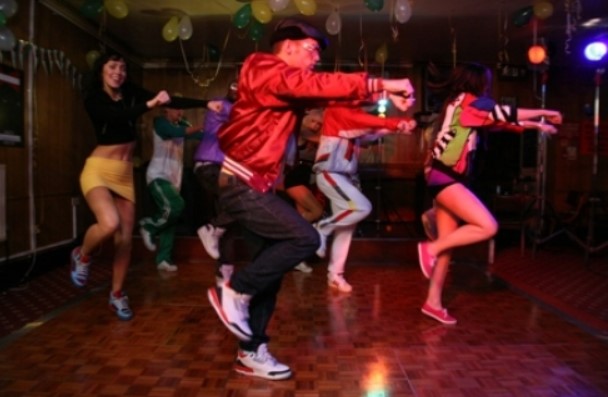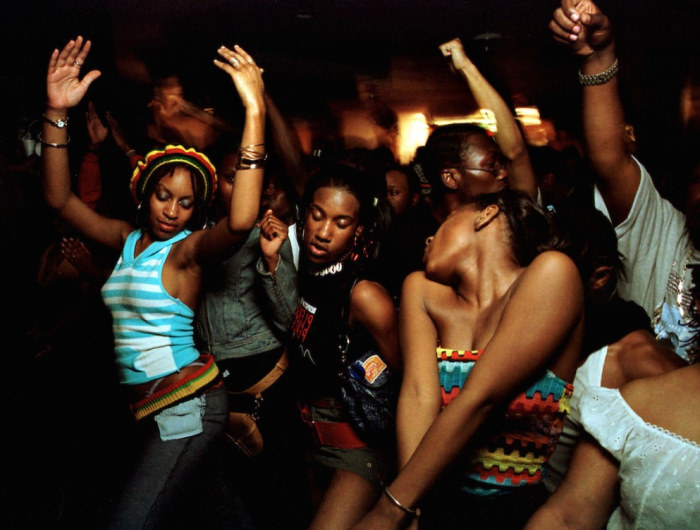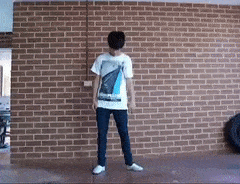When you want to have a good time, rave parties are almost always a top answer. If you’ve never been to such a party before, the scene can look hectic and a bit intimidating.
But really, though it may look complicated, rave dance moves are actually pretty easy to learn. Rave is different from other forms of dancing in that it’s a free-form, improvisational dance. In theory, you can dance however you want. There’s no “wrong moves” here.
Nevertheless, learning some basic, popular dance moves can build up your confidence and allow you to enjoy the party more. This guide can show you the gists!
Table of Contents
11 Essential Rave Dance Moves To Learn For Beginners
For newcomers, it can be beneficial to learn these basic types of rave dancing. It will give you an idea of how to start when the music comes up and you’re on the stage. The extra confidence that it gives you will be an added bonus, too.
1. Running Man

The Running Man is a move that you can pull when you’re stuck in the middle of a large crowd of ravers. Aside from being simple, you also have the added benefit of it being a static dance move. You merely dance in one spot without moving.
There are two counts to this move. When practicing at home, start slow and say each count aloud. Progressively get faster until you feel natural.
- Count 1: Lift your right knee to level with your waist.
- Count 2: Bring down your right knee. Halfway through the right foot’s downward movement, lift your left foot’s heel and slide backward on the ball.
Repeat the two counts, but this time on your left foot (raise your left knee to waist level on count 1, then lower your left foot and slide your right foot backward on count 2).
To make it easier to visualize the movement as you practice, imagine you’re walking or running in place. That’s exactly what you’re doing, anyway!
2. Break Dancing
Break dancing (or simply breaking) looks a lot more impressive on stage than Running Man.
Hop up on your right foot, then cross your left foot in front of the right and tap it on the floor. Repeat this motion with the other foot using a double hop.
If you want to add a bit more flair to the movement, you can cross your foot once, then shoot out to the side. That will make the dance a lot more exciting.
3. Jump Style
The basic description for this style of dance is hopping and jumping around with your foot raised, while your arms are kept hanging loosely by your sides. A simple beginner pattern involves five counts.
- Count 1: Hop up with your left foot and kick your right foot forward. Raise your right foot by about a foot high in the air.
- Count 2: Retract your right foot and repeats the first movement.
- Count 3: Switch your foot: hop on your right foot and kick forward with your left foot.
- Count 4: Hop on your right foot again, but this time, kick your left foot backward.
- Count 5: Hop on your left foot and kick your right foot backward. Keep it low.
You can repeat this simple dance sequence how many times you wish. You can mix up the movements or combine them with other moves to flesh out a jump-style dance routine of your own.
Jumpstyle is best done to the beat of hardstyle or gabber music, with a tempo ranging between 140 to 150 BPM.
4. Apple Picking Move
Similar to the Running Man move, the Apple Picking Move is very easy to learn and highly visual. When you dance, just imagine yourself plucking an apple from a tree overhead.
- Raise both of your arms as high in the air as possible, then drop them down.
- Sync your up-and-down movements to the rhythm of your feet.
- To add flair to the performance, you can spice it up by shaking your head and mixing in some other dance moves.
Do anything that you can do, so long that it suits the beat of the music and the mood.
If you practice in front of a mirror, the dance could look a bit silly. But don’t worry, that’s part of the magic of a rave dance (and a rave party). You’re not at all expected to look good. The “prime directive” is to have fun!
5. Melbourne Shuffle
Now, we’re not going to lie to you: the Melbourne Shuffle is a pretty advanced move. As such, don’t be discouraged if you don’t nail it on the first try. If you’ve had previous experience with hip-hop or breaking, learning this move would be a lot easier.
The Melbourne Shuffle is basically a mixture between the Walking Man and the Moonwalk. It involves very limited movement of your upper body. Most of the magic is produced by the legs and the arms as they sway in a natural, yet fluid, walking motion. Typically, the dancer will first face a singular direction before they begin to dance.
It is considered a flat-footed, stomping dance. While you’re caught up in the music, you can also add in pirouettes when the beats suit the move, too.
Do note that the Melbourne Shuffle takes up a lot of space. If it’s too crowded around you, it’s best not to execute it. You’d be at risk of colliding with somebody. In case you do want to try it out, you should seek a sparse spot in the crowd.
6. House Stepping
House stepping, like its name suggests, is best done with the backing of house music (Progressive House, Electro House, et cetera). This dance move simply involves raising your left and right foot up and down to the beat of the music. Your arms should be raised and your elbows tilted.
House stepping resembles Latin dance and Tap dance. Plus, since it requires a lot of upper-body movements, house stepping is basically the mirror opposite of the Melbourne Shuffle.
7. Liquid Movement
The Liquid Movement is definitely the toughest rave dance move that you can possibly learn. It’s most suited for people with high flexibility and previous dancing experience.
Liquid Movement is an off-shoot of more traditional break-dancing. When you’re breaking, popping and locking with your feet and hands are expected.
Not so with Liquid Movement. The moment you look too mechanical while executing this move, you’d look out of place immediately. Liquid Movement is all about dancing as fluidly and as naturally as possible to the music, which is why experts at this dance move are often called “octopuses”.
Liquid Movement uses the entirety of your body to simulate the sense of fluidity, which is why a high degree of body flexibility is required for people hoping to execute this dance move.
8. The Stomp
The Stomp is yet another simple and visual dance move. Imagine yourself treading on thick snow. Move and stamp your feet from side to side to the beat of the music.
That’s all there really is to the move. It’s a great opener or beginner move. Combine this with the Running Man or Apple Picking and you got yourself a pretty solid basic rave dance routine.
9. Glowsticking
For Glowsticking, you’re going to need some extra accessories. Particularly, you will need some glow sticks (also called rave lights). They can be battery-operated or chemical glow sticks. It doesn’t really matter so long that they glow.
Hold one stick in each hand and dance. Usually, glow stick dancers favor Liquid Movement dance. The fluidity of the dance, when combined with the glowsticks, makes them truly alluring on the dance floor. Even though raves aren’t really about attracting attention, if that’s what you set out to do, it’s a sure-fire way to attract the eyes of other party-goers.
Experienced glow stick dancers may swirl or juggle the sticks around to create a visual feast for other guests. Some attach glow sticks to thin cords and spin them around to create beautiful wheels of light in time with the beat of the music. This type of dance is called “poi”.
If you manage any of that, you’d definitely be the star of that night’s show.
Glowsticking is one of the four light-oriented dances out there.
10. Gloving
Gloving, like Glowsticking, is a light-oriented dance. Instead of using glow sticks, the dancer uses small LED lights attached to their fingertips (hence the term gloving) to make attractive visual patterns.
Because the literal highlight of the dance lies in the diodes attached to your fingertips, gloving is basically a rave dance with your hands and fingers. You will want to incorporate movements that make your hands and fingers stand out as much as possible.
Liquid and digits moves, for example, where you move your body fluidly while also constructing hypnotizing patterns with your finger digits. Finger tutting is also worth looking into if you’re serious about learning Gloving. It’s a dance style that involves intricately moving the fingers around, which will be further accentuated by the fingertip diodes.
11. Hakken
Hakken is a dance style originating from the Dutch hardcore and gabber dancing scenes in the 1990s. The term Hakken is derived from a Dutch verb, which means chopping and hacking.
Basically, the dance is a derivative of zapateo, but with fewer airborne movements. You perform tiny steps with your feet to the rhythm of the bass drum in the music.
Similar to the Melbourne Shuffle, the lower body plays the most important role in this dance style. However, it’s not unusual for Hakken dancers to incorporate their upper body movements into the routine, too.
Hakken is a very high-speed dance. The music (called hakmuziek) can have a tempo as high as 190 BPM. It’s going to take some work to be able to catch up to the beat.
Rave Dancing Tips To More Confidence
Dancing at a rave is a communal experience. Keep these tips in mind:
- Respect Personal Space: Be mindful of others. Stay in your own space unless invited to dance closer. Avoid bumping into people, especially when dancing animatedly.
- Dance to Express, Not to Impress: This cannot be stressed enough! No one is judging your moves. Everyone is there to enjoy the music and the atmosphere. Let loose, act silly, and have fun.
- Practice Makes Progress: Feeling self-conscious? Practice your moves at home in front of a mirror! This builds muscle memory and confidence. There are countless video tutorials online on YouTube and TikTok for specific moves.
- Bring Friends: Going with friends can significantly reduce any initial stress or awkwardness. You can hype each other up and learn together.
- Hydrate! Dancing can be intense. Remember to drink water throughout the event.
- Consider What You Wear: Sometimes wearing sunglasses or a pashmina can make you feel less “exposed” and help you let go.
1. Can I use glowsticks without formal training?
Absolutely! You don’t need structured lessons. Start tracing simple figure-eights or wave motions slowly to match mid-tempo beats for instant visual impact.
2. How do I avoid stepping on others at a crowded rave?
Use compact footwork like the Running Man or elbow-led gestures, and always watch your immediate space; your presence matters more than flashy steps.
3. What should I eat or drink before a rave?
Choose light, slow-digesting carbs (bananas, oatmeal) and electrolyte drinks for steady energy. Hydrate early and consistently throughout the event to stay alert and fluid.
Final Words
Raves are an excellent way to let loose and have fun after a hard week. Allowing yourself to get lost in the music and the intense energy of the night is a wondrous feeling. With these basic rave dance moves, you’re more or less ready to attend your first of many rave parties in the future!
Hopefully, this guide has served you well. If you have any other questions you’d like to ask, leave them in the comment section below and we’ll get back to you as soon as possible.



